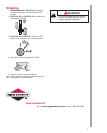
8
Oil
Capacity
Engine holds approximately 1-1/2 quarts (48 ounces or
1.4 liters) when changing oil and oil filter.
Oil Recommendation
• Use a high quality detergent oil classified “For
Service SF, SG, SH, SJ” or higher. Briggs &
Stratton strongly recommends the use of
synthetic oil. If synthetic oil is unavailable, Briggs
& Stratton non-synthetic 30 weight oil P/N
1000005 (20 oz.) or P/N 1000028 (48 oz.) is an
acceptable substitute.
• Do not use special additives.
• Choose a viscosity according to the table below.
Note: Synthetic oil meeting ILSAC
GF-2, API certification mark and API
service symbol (shown at left) with
“SJ/CF ENERGY CONSERVING” or
higher, is an acceptable oil at all
temperatures. Use of synthetic oil
does not alter required oil change
intervals.
°F
-20 0 20 40 60 80 100
°C
-30 -20 -10 0 10 20 30 40
STARTING TEMPERATURE RANGE ANTICIPATED BEFORE NEXT OIL CHANGE
*
**
32
SAE Viscosity Grades
CAUTION
* Air cooled engines run hotter than
automotive engines. The use of
non-synthetic multi-viscosity oils (5W-30,
10W-30, etc.) in temperatures above 40° F
(4° C) will result in higher than normal oil
consumption. When using a multi-viscosity
oil, check oil level more frequently.
** SAE 30 oil, if used below 40° F (4° C), will
result in hard starting and possible engine
bore damage due to inadequate lubrication.
Checking and Adding Oil
• Check oil level before starting the engine.
• Keep oil level at FULL. Do not overfill.
• Check level daily, or after every eight (8) hours.
1. Place engine level and clean around oil fill and
dipstick area.
Dipstick
Oil
Fill
2. Remove dipstick and wipe with clean cloth. Then
push dipstick back in and remove to check oil
level.
FULL
3. Remove oil fill cap. Pour oil slowly. First add 1 qt.
(32 oz. or 1 liter). Start and run engine at idle for
30 seconds. Shut off engine and wait 30 seconds.
Then add more oil slowly to bring level to FULL
mark on dipstick.
4. Fill to FULL mark on dipstick. Recheck.
FULL
5. Replace dipstick firmly.


















